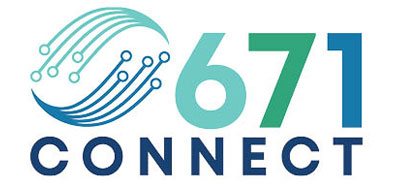Broadband Adoption and Why
Broadband adoption lies at the heart of a community's ability to thrive in an increasingly digital world. While having the infrastructure for high-speed internet is crucial, its full potential is only realized when individuals and institutions actively incorporate digital tools into their daily lives.
Without adoption, access remains an underutilized asset, like to a library where books are rarely read. To truly bridge the digital divide, we must prioritize a comprehensive strategy that boosts adoption, supported by increased access. This strategy would combine awareness efforts, educational programs, infrastructure initiatives, and collaborative endeavors. With a keen emphasis on both adoption and access, we set the stage for a future where all members of our community are not just connected, but empowered to harness the full spectrum of digital opportunities.
Public Awareness Campaign:
Launch a targeted public awareness campaign to educate individuals and businesses about the benefits of broadband internet and its relevance to their daily lives. This can include digital and traditional media advertisements, community events, workshops, and partnerships with local organizations.
Digital Literacy Programs:
Develop and implement digital literacy programs that provide training and resources to individuals who may be unfamiliar with using the internet or lack the necessary skills to navigate online platforms. These programs can be conducted in partnership with community centers in the villages, schools, libraries, and other local institutions.
Affordable Internet Options:
Work with internet service providers to develop affordable broadband packages specifically tailored to low-income households and underserved communities. This can involve negotiating discounted rates, offering subsidized plans, or exploring partnerships with government assistance programs to make internet access more affordable and accessible.
Infrastructure Expansion:
Invest in infrastructure development to expand broadband coverage to underserved areas. This can involve building additional network infrastructure, deploying wireless connectivity solutions, or utilizing innovative technologies like satellite internet to reach remote locations. Collaborate with private sector entities and leverage public-private partnerships to expedite the expansion process.
Community Wireless Internet Networks:
Establish and provide available basic wireless internet throughout the community. By expanding wireless internet networks available in public spaces such as parks, libraries, and community centers, and building upon existing public wireless networks, we can provide free or low-cost internet access to residents. These networks can bridge the digital divide and ensure that individuals without home internet can still connect to essential online services and resources
Partnerships and Collaboration:
Foster partnerships and collaboration between government agencies, internet service providers, educational institutions, and community organizations. By working together, stakeholders can pool resources, share best practices, and collectively address barriers to broadband adoption, such as affordability, digital literacy, and infrastructure challenges.
By implementing these action steps, communities can foster a culture of broadband adoption, empower individuals with digital skills, and bridge the digital divide, leading to increased access and utilization of broadband services to all.
Addressing Affordability
Why affordability matters in Guam
Broadband affordability is a major concern in Guam, where residents face among the nation's highest internet rates. Various stakeholders pinpoint these costs as the principal barrier to widespread broadband adoption. However, the underlying reasons for such high rates remain a mystery to consumers. For many, the prohibitive cost leads to financial burdens and a growing disconnect to affordable broadband.
In the unprecedented era of worldwide internet, broadband access is more than just connectivity—it's a lifeline to education, healthcare, and civic engagement. When such essential access is prohibitively priced, it constrains opportunities across sectors. The lack of cost transparency further widens the digital divide and society as a whole suffers.
Addressing Guam's broadband challenge necessitates more than just cost adjustments. Transparent and truthful communication regarding the factors driving these costs can build trust and pave the way for a more digitally inclusive Guam.
To address the need for affordable and reliable broadband service, Guam has developed an action plan with the following key steps:
Clearly Define Affordable Broadband Service Categories:
a. Residential Broadband Serviceable Location: Ensure fixed broadband internet access is available for residential structures.
b. Business Broadband Serviceable Location: Extend internet access to all non-residential structures, including businesses, government entities, and non-profit organizations.
c. Price Target: Set a reasonable monthly cost for residential and business broadband service.
Define Standards for Residential Affordable Broadband Service:
a. High-Speed Internet Service: Provide download speeds of 100 megabits per second and upload speeds of 20 megabits per second to residential locations for at least 95% of the subscribed service duration.
b. Low Latency: Maintain round trip times to the nearest U.S. -based internet exchange point below 100 milliseconds for 95% of the subscribed service duration.
c. Reliability: Ensure uninterrupted connection availability, regardless of weather conditions, with outages not exceeding 99% of the subscribed service duration.
d. Affordable Subscription Cost: Offer a mass-market, non-discounted subscription at, or below, $75 per month.
Define Standards for Business Affordable Broadband Service:
a. High-Speed Internet Service: Provide download speeds of 100 megabits per second and upload speeds of 20 megabits per second to business locations for at least 95% of the subscribed service duration.
b. Latency: Less than 100ms.
c. Reliability: Ensure uninterrupted connection availability, regardless of weather conditions, with outages not exceeding 99% of the subscribed service duration.
d. Affordable Subscription Cost: We will engage in a collaborative process with businesses, potential business owners, and Internet Service Providers to determine an appropriate range of price targets. These targets will be applied uniformly, with flexibility for tailored agreements based on specific business needs, ensuring a balanced approach that serves the interests of all parties involved.
e. Universal Availability: Ensure that internet service is accessible to all businesses, organizations, institutions, and government entities.
By implementing this action plan, Guam aims to establish clear standards for affordable broadband service in both residential and business categories. This will enable residents and businesses to access fast, reliable, and affordable internet services, promoting digital inclusion and supporting economic development on the island.
Broadband Access
Broadband access in Guam today is marked by a stark contrast between the potential offered by new technological advancements and the ground realities faced by a significant portion of its residents.
Limited Fiber Optic Reach:
Despite the technological advancements globally, fiber-to-the-home (FTTH) connectivity in Guam is still in its nascent stage. As of today, less than 20 locations have access to FTTH. This infrastructure offers high-speed, low-latency connectivity, but its limited reach means most of the island's residents can't benefit from it yet.
Reliance on Older Technologies:
In the absence of widespread fiber coverage, a majority of households and businesses in Guam rely on older broadband technologies like DSL (Digital Subscriber Line) or cable. These technologies, while providing internet connectivity, are not as fast or reliable as FTTH and tend to have higher latency issues.
Affordability and High-Cost Plans:
Even though there are multiple providers like GTA Teleguam and Docomo Pacific offering various broadband packages, the costs associated with these plans are relatively high. Such expensive plans limit digital accessibility, especially for households with limited incomes.
Universal Access Challenges:
The digital divide is evident in Guam. More densely populated villages and areas might have more available, albeit older, internet technology access. In contrast, more sparsely populated villages and areas face both connectivity and affordability challenges.
Natural Disaster Vulnerability:
Typhoons, such as Typhoon Mawar, underscore the urgency for a resilient broadband infrastructure. Such natural disasters can cause disruptions, emphasizing the need for resilient systems.
SEA-US Cable and the Future:
Guam's inclusion in the SEA-US submarine cable system gives it a bandwidth advantage. However, effectively leveraging this system for the benefit of every resident requires more comprehensive strategies, especially in expanding Fiber To The Home (FTTH).
Pace of Improvement:
The speeds available to Guam consumers have lagged behind increases in most of the world over the last five years. Where we are only starting to see consumer plans at high prices get closer to the served 100 Mbps standards, around the world the pace of speed is increasing daily. As seen in the chart below Guam's highest speed aggregate measured by Ookla data has remained nearly flat compared to Hawaii, Puerto Rico, and small remote areas such as Bozeman Montana – which has a third of Guam’s population.


